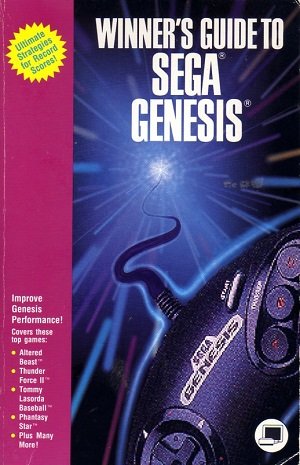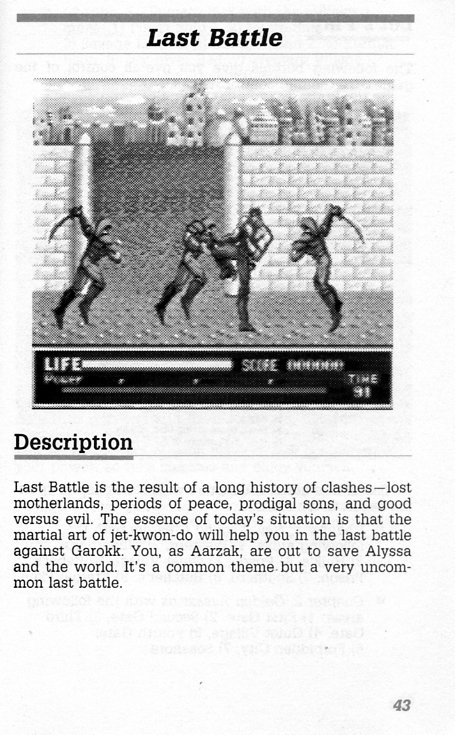
Listen up, chumps: when it comes to gaming, you've got two choices. You can be a loser, or you can be a winner. Losers take forever to get anything done. They start games, they get a little ways in, they face their first major challenge, and then they give up. They quit. Game over. Eject the cartridge and go do something else.
Winners may not beat the game the first time, but they're persistent. They know what they want, they go for it, and they keep going for it until they've achieved not just victory, but dominance over the game. When the console throws up its hands in surrender, that's when you've truly won. Whether it's slaying the dragon, rescuing the princess, or rolling the score so high it goes back to reading all zeroes, a winner doesn't stop until the CPU commits digital seppuku rather than start up another round.
Proving that girl gamers have always been with us, Winner's Guide to Sega Genesis author Kate Barnes goes on the offensive with strategies for thirteen top Genesis titles and six best-selling Master System carts, all crammed into 150 pages. For $9.95 US or $12.95 Canadian (yeah, how do you like that maple syrup now, you hockey-obsessed nut-jobs?), these killer combos and trap-busting tips can be yours. So strap on your bits (all sixteen of 'em), grab that three-button controller, and hop on the bus to Beat-Down Town for this edition of the column I like to call...
To Guide or Not to Guide?
Winner's Guide to Sega Genesis wasn't the first book on the market devoted to Sega's sleek black living room invader (that honor goes to COMPUTE's Guide to Sega Genesis), but it was the first written by a woman. Kate Barnes was no stranger to the world of computers, having also published books about WordPerfect and Apple Writer II, but this was her first excursion into the world of video games.
The style she chose is similar to other gaming books by Hayden Publishing. Each title is presented in alphabetical order, with a representative screenshot, a rundown of its options and controls (in case your manual was missing), and a few paragraphs summarizing the purpose of the game.

For example...
This is followed by two strategy sections, ostensibly compiled and suggested by two different gamers: 'Hi' and 'Tec'. Don't be fooled--they're both Barnes (they're also both female, as they refer to one another as 'she' and 'her' when they discuss two-player strategies, like with Golden Axe), but she uses the two personalities to suggest different (occasionally contradictory) methods for approaching victory. Following these two characters' breakdowns, a final section entitled "More Power Pointers" offers a bullet-pointed list comprised of both in-game strategies and cheat codes to push you the extra mile. Finally, Barnes includes some information about the publisher: who they are, how to contact them, a game tip phone number, and how much you should expect to pay for the game in 1990 dollars.
The games covered are: Alex Kidd in the Enchanted Castle, Altered Beast, Arnold Palmer Tournament Golf, Ghouls 'n Ghosts, Golden Axe, Last Battle, Rambo III, Super Hang-On, The Revenge of Shinobi, Thunder Force II, Tommy Lasorda Baseball, World Championship Soccer, and Zoom! on the Genesis. Master System games are Alex Kidd in Miracle World, Phantasy Star, R-Type, Reggie Jackson Baseball, Shinobi, and Wonder Boy in Monster Land. Quite a roster of hits there.
Not to Guide
This is one of those books that initially looks impressive, but winds up falling well short of expectations upon close inspection. The screenshots, while in black and white to save on printing costs, are at least high enough resolution that you can tell what you're seeing. Some of the NES books from this era can't even get that right.
There's nothing wrong with Kate Barnes' writing style, and splitting herself into two personas for the 'Strategy' sections is a cute gimmick. I even like the fact she covers the controls, because back in the day it wasn't uncommon to rent a game and not receive the manual with it, or have a friend bring you the cart without the booklet. Sega games from this early in the system's life aren't that difficult to figure out, but it's still a nice touch anyway.
My main gripe is that many of the tips and tricks divulged are so obvious as to be insulting. Pointing out the player has a few frames in invincibility after getting hit in Ghouls 'n Ghosts, or suggesting you pause the game to compose your thoughts in the middle of a hectic World Champion Soccer match are things any gamer will learn pretty much upon pressing Start. The information on Phantasy Star, the one Master System title in here that really could have benefited from some extra tips, is pretty much what you'd get out of the manual. Barnes even points out the strategy guide available for Phantasy Star II (a game that should have received coverage in this book) and how useful it is, but then provides zero useful info or tips for the predecessor. No maps, no item stats, and no walkthrough beyond some general information about where you'll go, what you'll see, and what equipment your party members should look for (but no info on where to buy/find it). This is just sad.
The company information after each game would have been useful at the time, but everything except the price is duplicated in every entry, making this a colossal waste of space. A simple remark on the retail price, and a single print-out of this information in an appendix would have saved enough pages to squeeze in either more hints for the 19 titles included, or allowed for one or two additional ones. How many times does one need the name, address, and game counselor number for Sega of America, Inc. repeated, anyway? What's more, Thunder Force II and Ghouls 'n Ghosts were not programmed by Sega, but the contact information is for Sega of America anyway, not TechnoSoft or Capcom. It's not a terrible oversight by any stretch of the imagination, since nobody was buying this book to help them figure out the company responsible for programming the game, it just would have been nice to see the correct info here.
Ultimately, this is a book that was rife with potential, but squandered every last bit of it. For the curious among you, it's certainly priced right at under three dollars on the secondhand market, but honestly unless you're trying to acquire a complete retro gaming book library, this one outlived its usefulness a month or so after its publication date. Don't waste your time--the only winner here was Hayden Books, who was all too happy to take your money and run.
Do you own a copy? And have you bought it back in the day?
What I'm curious about is whether the book seemed any better back then and looks silly now looking at it through years of experience or if it felt like that from the get go?
Downvoting a post can decrease pending rewards and make it less visible. Common reasons:
Submit
Oh yes. I own physical copies of every game book I write about on here. Most of them were acquired at or around the time of publication, but I've worked to fill holes in my collection over the years.
It seemed pretty neat back then, but then again, to a video-game-obsessed twelve year old, every book about video games seemed pretty neat back then. This was a recent addition to the collection, but the other Hayden publications in my collection were not. I try and review based on how useful the book would have been when published as opposed to now (when GameFAQs and other sites can spoil everything with a few mouse clicks), and unfortunately that means sometimes having to drop the hammer on the rose-colored lenses of nostalgia. :)
Downvoting a post can decrease pending rewards and make it less visible. Common reasons:
Submit